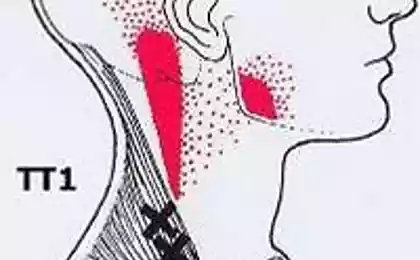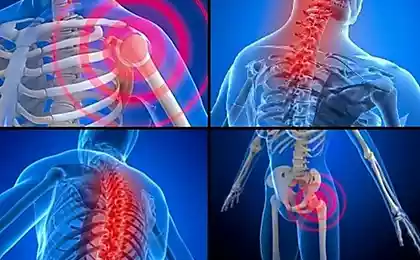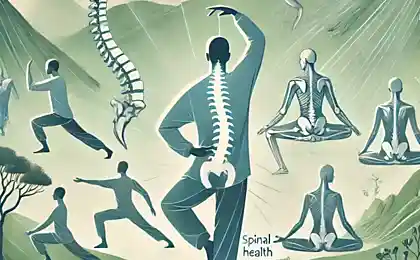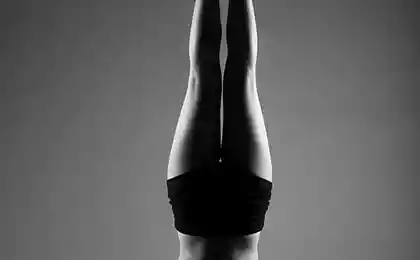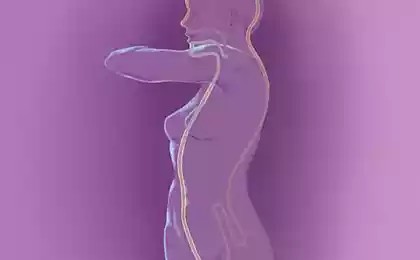684
Yoga exercises for pain in the back

We can say that the back and the spine in particular, are one of the main objects of yoga therapy, as they represent the main load, and through the spine are the main nerve channels connecting the brain and organs.
Yoga for sore back very effective, but the fact is that back pain can have different causes, some of them are not recommended for certain movements, such as scoliosis need to be very careful with the twisting of the spine (in most cases, they are simply forbidden). Therefore, before proceeding to the self through yoga, be sure to find out the causes of your pain and what types of physical activity you can.
The most common cause of back pain is incorrect posture and weak muscles, with the result that there are stretching or even displacement of the vertebrae. Sometimes pain arises due to an old injury or due to severe or prolonged stress — there can also help yoga.
Harder scoliosis and herniated disc — before you do, be sure to consult your doctor to avoid injury in yoga.
Yoga Against Back Pain — Important notesBefore we move on to yoga poses that help overcome or alleviate back pain, want to give a few tips.
Breathe deeply, but without strain, trying to reconcile the movement with the breath. Upon reaching the end position of the posture we also need to continue deeply and breathe freely, if there are no other instructions.
Take your time when performing yoga poses; it is not even to avoid injury (but this, of course!) — just at a more measured performance of poses you can "dive" into the process, and gain more effect and benefit. In addition, most yoga poses in its final phase just assume that the delay, combined with relaxation and deep breathing for maximum effect.
Be careful in your practice. Our consciousness plays a huge role in yoga — because sometimes the effectiveness of the practice can be increased up to 50% with quiet concentration on the process.
Also very important is the regularity in practicing yoga, whether General practice or therapeutic, i.e. curative. Regularity allows our body to start to readjust in the right direction for us (in this case, in the direction of improve the back condition until its complete cure, if possible). The ideal — to do yoga every day; if for some reason impossible, engage in a day or three times a week. More spacing will produce much less effect.
If you feel severe fatigue or pain, gently stop the practice.
Do not do yoga. Of course, if you just do not want, that is no reason to take time off from classes; the phrase "by force" I mean the practice when you already feel exhaustion, but trying to finish the planned number of asanas; or when you can't take the final form of the particular poses, but too tense to do it. Take your time, everything will come in due time.
Practice1. Pamahalaan or tilt forward.
This is the first pose that I normally always recommend. Note, some serious diseases of the spine bending forward is forbidden!
Stand up straight, feet shoulder-width apart and parallel to each other. Inhale — exhale and gently lean forward. If you can touch the floor or grab of the ankle. But not too hard — the main thing here is to try to relax. Hold the pose for 5-8 breaths and on the inhale return to starting position.

2. Gomukhasana or "cow face"
Sit on the floor, legs forward; bend one knee and pull your leg, the second leg also fold and place on top of the first. Adjust the position of the feet to be comfortable. Turns out that you sit between your heels. Now, arms out to side and bend them, placing one hand on top of the back, second from the bottom in the back. Try to connect my hands behind my back. In the end position, breathe normally, trying to keep the chest and shoulders; do not strain. Again, do exercise — symmetrically by putting the "lower" arms and legs up.

3. Setu-asana or bridge pose-supported
The pose helps to gently arch the back, to reveal the chest. Lie on your back, bend your knees and move the hips. Knees pointed toward the ceiling. Lift your hips and lower torso to a comfortable height. If you find it difficult to remain in this position only at the expense of muscle, pelvic bone substitute a yoga block. Stay in the pose for a comfortable time for you.
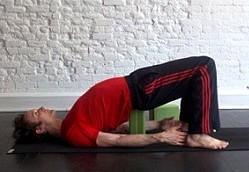
4. Halasana or the plow pose
This pose is very effective, but can be difficult to master at first. Lie on your back, arms along the body. Inhale, exhale, and press your knees to your stomach (legs bent). Next, gradually lift your pelvis, straighten your legs and place them behind your head. In the end position, stay as long as comfortable, breathing freely. With an exhalation, return to lap of stomach, then slowly straighten legs and lie down for a few moments, relaxing.

5. The position of the sleeping eagle
Easy twist — lie on your back, then bend one leg at the knee, tighten the abdomen and place on the floor to the opposite side (if left leg is bent, then to the right; the head turns to the left). Stay in this position, breathing freely, until you are comfortable.

6. Opening of the chest support
Sit, legs forward. Back put the prop (yoga block or pillow). Will need another prop for the head. Gently lean back so that the Central and thoracic spine rested on a stand; place the stand on your head. Raskinte hand in hand, relax. Do about 3-5 minutes, or until comfortable.

7. Posture to relieve tension in the hips and lower back
A fairly simple pose: lie on your back, bend one leg and put the foot next to the hip. The second leg is bent and placed on top of the bent. Slips his hand through the hole under the knee of the leg that on top, grab the leg that is on the floor, and gently pull on yourself. The upper leg slightly moves inward, increasing the tension. Change legs. After return to the position lying on the back.
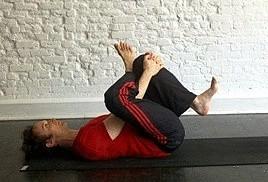
8. Pavan-muktasana
Lying on your back, bend one leg and pull it as close as possible to yourself — help yourself with the hands. Hold at end position, feeling the stretch in the lumbar spine and hip, and then lower the leg and repeat with the other leg.

9. The rotation of the feet while lying
Lying on your back, lift one leg to the perpendicular position relative to the floor, if possible (try to keep it straight as you can, then lower it in the opposite direction, trying not to bend at the knee. Reach for her hand and try to grab the ankle or foot. Lie down so, while comfortable, breathe freely. Repeat in the other direction.
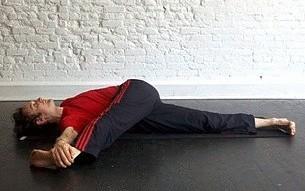
Here's a simple but effective yoga for back pain. Take your time but do it regularly on an empty stomach. You can gradually get rid of back pain — how, it will depend on you, your determination and patience. Good luck! published
Source: denissvetlichny.ru
Robots-terminators is a unique technique for the Chernobyl nuclear power plant
Meditation rocks by Michael Grab
